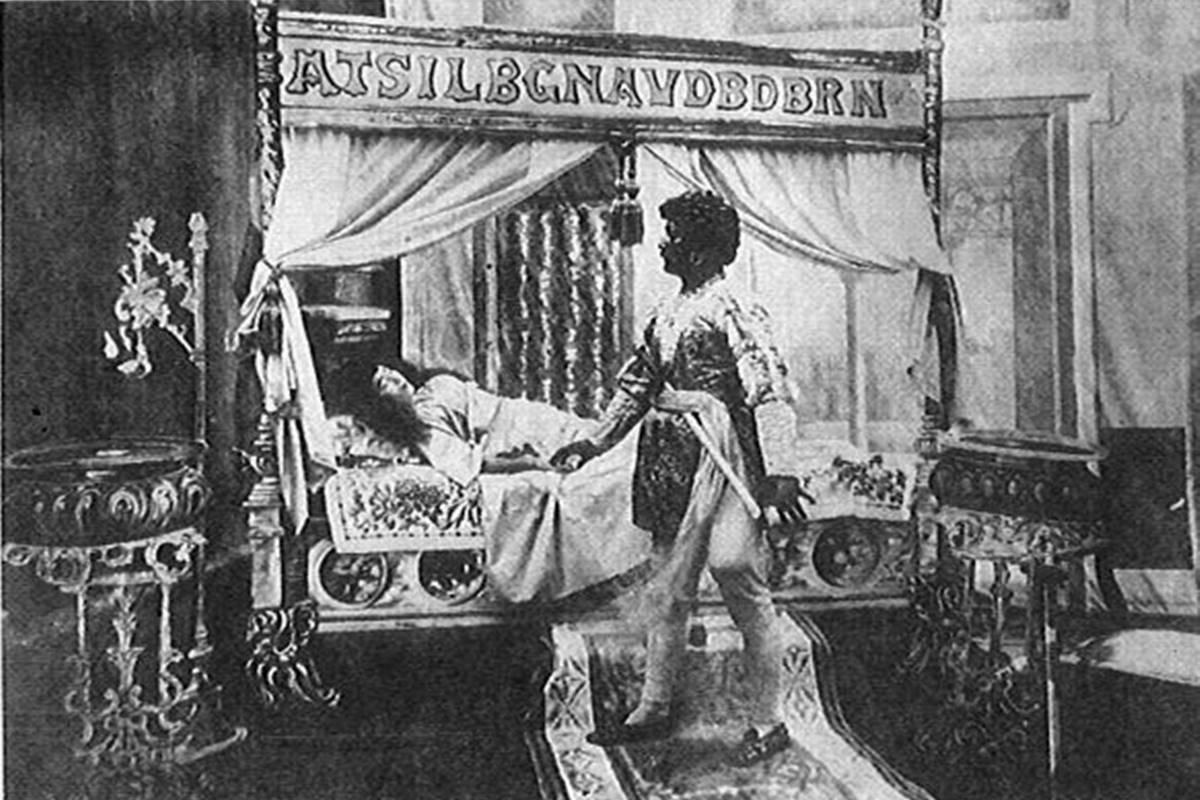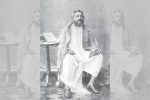Flair for Natyashastra and Bharatanrytam
A beautiful interactive session was held the next morning by Dr Padma Subramaniam on Natyashastra and National Unity with a live demonstration by Gayatri Kannan at the Kolkata Centre for Creativity.
William Shakespeare’s works were Indianised in the early 20th century Bengali stage by incorporating elements from Indian myths and the Natyashastra

A scene from a performance of Othello at Star Theatre in 1919
The presence of William Shakespeare in India is older and perhaps more complex than in any other country outside the Western world. And that is largely because of two reasons —one, India’s long colonial history; two, the unusually receptive elements in the mother culture. The regional cultures of most of our states have proved to be ideal mediums, capable of absorbing Shakespeare well within their structural ambit, and, in turn, be reshaped and inseminated by Shakespearean influence.
Our sociopolitical history indicates that from mid-19th to early 20th century, the impact of Western creativity upon our society was at its height because Western philosophy, art, and technology fascinated us. And this phenomenon termed as the Indian Renaissance impacted all strata of our national culture —socio-political, economic and even art. In the given scenario, Shakespeare’s impact, even though small compared to the whole, undoubtedly provided the biggest single outlet for not only literary or artistic innovations but underlying transformation of our values.
Traits and values were not merely imbibed through or from Shakespeare; to a large extent, Indian values and practices were implanted on or even evolved through his work. Shakespeare thus became the designation for a commodity and a culture in a manner comparable only with the developments in the West.
Advertisement
Chronologically, the permeation of Shakespeare into the Indian psyche occurred with the productions of the most culturally uncomplicated “garrison theatres” catering to the British colonists. Theatres were built in all major trading centres within the Empire, and Shakespeare provided a prestigious part of the repertory. Initially it began with performances of Shakespearean plays, by English troupes in Bombay from 1770.
In Calcutta, then capital of British India, the earliest recorded performance is of Othello at the Calcutta Theatre during Christmas of 1780. Over the next eight years, Hamlet, The Merchant of Venice, Romeo and Juliet, Richard IIIand Henry IVwere enacted at the same venue. Performances continued unabated, till the mid-19th century, chiefly at the Chowringhee (the teeming heart of Kolkata) and Sans Souci Theaters. And the earliest notable tours were undertaken by Lewis Theater Company in the 1870s and Maurice E Bandmann’s Company in 1880s.
Touring companies however, became famous only in the heyday of the Raj, from the late 19th century. Next with growing interest in Shakespearean plays, local theatrical companies came into existence, especially in Bombay.
Consequently, in 1868, the Oriental Theatrical Company started performing Shakespearean plays followed by the Parsi companies. In the academic sphere of 19th century Bengal, it was Richardson, an eminent English teacher of Presidency College, who first ventured to develop a literary taste for Shakespearean dramas in the minds of his Indian students. He taught them to recite and enact scenes from Shakespearean plays.
In response, in 1837, several Bengali students performed The Merchant of Venice in the governor’s house, Othello in 1853 at the Oriental Academy and Henry IVin 1855. Subsequently, the growing success of Shakespearean performances, inspired many regional playwrights to both translate and adapt Shakespeare in vernaculars — thereby leading to a spurt of translated and adapted Shakespeare in several Indian languages for performance on Indian stages.
However, despite the best efforts of the enthusiastic regional dramatists, India initially remained a mere outpost of Shakespeare performance; quite untouched by the greater phenomenon of Shakespeare. Radical departure occurred, when Shakespeare entered the curriculum of the new Western-style education. By the continuing paradox inherent in Indian society, this Western infusion was then absorbed into the cultural mainstream of Indian languages.
Although the Romantic image of Shakespeare as poet or Bard was clearly dominant with Indian writers who would never see a play staged in English, and might have reacted to an Indian-language production with critical or even moral disapproval.
Commenting on this growing occurrence, Pooman Trivedi writes in her book India’s Shakespeare: Translation, Interpretation and Performance. “Shakespeare’s long and pervasive influence on dramatic activities in the nineteenth century resulted in widespread adaptations and translation of his plays. To make the borrowing more acceptable to a wide variety of audience the plays were Indianised to a large extent by adding songs and dances in keeping with the geetinatyas, (kind of opera) which were very popular.”
In Bengali the earliest recorded public performance of Shakespeare was the Comedy of Errors, (1873) about which little is known. Next year Cymbeline and Macbeth were adapted for performance while the following year Othello followed suit.
On 28 January 1893, came a brilliant translation of Macbeth by Girish Chandra Ghosh, the doyen of Bengali theatre. According to Utpal Dutt, it “has not been equaled yet.”

About the performance, Dutt observed, “With his usual fastidious care, for detail he hired an English stage designer of the city Pym by name to build the sets and make the costumes.”
Consequently, when the play was enacted, critics were astonished to note an authentic version of the Scot style, followed in the 17th century. Though a masterpiece in poetic translation, it flopped on stage. The humiliation increased when in 1897 Nagendra Nath Chaudhuri’s Hariraj, a much cruder version of Hamlet appeared, and enthralled audiences for years.
True, Ghosh’s translation couldn’t please the Bengali audience, but academically none could either match his brilliance or undermine the translation, and fidelity to the original work. There were structural variations due to Ghosh’s preference for his roots, ie the Sanskrit plays. Hence, instead of Shakespeare he adopted the structure of Sanskrit plays. Being a successful dramatist he knew that his penchant for Sanskrit play structure would go down well with his viewers. But unlike his compatriots, he was uncompromising regarding the plot, characterisation and nomenclature of the play. As an alternative, he tried to evolve a new semantic style for making his work sound more Bengali than English.
To Ghosh, adapting Shakespeare for the Bengali stage was more of a challenge than mere love for the Bard. Thus the original is rendered almost verbatim in Bengali blank verse and prose, with slight expansion here and there. Remaining committed to the tenets of Sanskrit plays, Ghosh evolved a new framework for Shakespearean Macbeth.
Instead of the ambiguous opening of Shakespeare’s Macbeth, Ghosh provides Macbeth with Naandi — an invocatory verse; and no scholarly eyebrows are raised among the audience when the play is performed. Naandi serves twofold purposes in the play — it placates the taste of the viewers, comfortable with Bengali version of Sanskrit plays; two, it immediately bolsters the typical attitude of the translator — a refreshingly non-Western and non-Aristotelian approach. Instead of the Mimesis or Catharsis it aspires to arouse Bharata’s Raudra Bhayanak rasa in viewers.
Girish’s Naandi begins on a humble note indicating the playwright’s intention for adapting the play:
To my learned audience, I have come to the stage
To manifest a trifle poetic gift of mine…
Shakespeare is my role model…
I am only an actor, follower of the Bard.
Hence, criticism of his creation is not within my purview.
I know not what inspires me
Yet, with all humility I desire
To offer my token of regard to the great poet.
This is in clear violation to Shakespeare’s Macbeth. Shakespearean play had no introductory words derived from Holinshed’s Macbeth. Thus the approach in itself is contrary to the Western concept. And it has happened because Ghosh followed the rulings of Bharata’s Natyashastra —a play should begin with Naandi for the playwright to notify the audience about his intention in writing the play.
Neither Shakespeare nor Aristotle’s Poetics instructs dramatists to begin a play with such a justification. Yet Ghosh deliberates this deviation to assure his audience that the play, though derived from foreign source, has not moved away from its soil. The other structural change that occurs in the opening scene is in the role of the witches.
At the end of the first scene the troupe of witches, utter mumbo jumbo clearly pointing to the inclusion of chorus, which is not there in Shakespeare. In all likelihood, such regional translations were not simple translations in the normal sense of the term, but acts of appropriations and expropriations. They attempted to take over and assimilate the new into an already existing native tradition. And the native tradition appeared to be unconsciously aware of the strength it accrued by such actions of appropriations.
The other indigenising device, which significantly alters the import of the original play, is the use of figures of speech that are strongly anchored in and possess an inextricable relationship with Indian myths and legends. These change both the texture and the meaning of the narration:
First Witch: listen o, listen,
There was a girl sitting,
With her hair let down, uncovering herself
Eating peanuts gluttonously.
When I asked some from her
Twisting my nose the virago (para kunudulay magi) yelled
‘Out you go,you rogue’.
The connotations “hair let down” and “uncovering” ones’ self are clearly meant to insinuate the Indian audience since, letting down one’s hair publicly or uncovered head of a girl smack of ill omens. It’s inappropriate for an Indian girl to let down her hair for public viewing; added to it, it is highly socially indecorous for her to appear in public without draping herself completely with clothes. By violating these two social strictures the girl is likely to instigate evil forces.
Furthermore, twisting the nose of the witch connotes Lakshman’s (brother of Rama in the Ramayana) striking off the nose of a she demon, when she approached him with a marriage proposal. Hence, striking off or twisting the nose, is the expected punishment meted out by an Indian to extraterrestrial creatures.
Shakespearean “rump-fed ronyon” however, suggests a woman of dubious character. Shakespearean lady merely squeals at the witch and refuses to part with her peanuts —the question of twisting the nose or other kinds of physical punishment do not arise as Elizabethans were afraid of bodily contact with weird creatures.
Likewise, para kunudulay magi instead of “rump-fed ronyon” — is another interesting term. Magi in Bengali connote a commoner; so the lady concerned, to an extent, shadows Shakespearean rump-fed “ronyon”. But unlike Shakespearean depiction she is Amazonian in valour — daring to touch a witch. A lady who dresses in this fashion and twists the nose of an unknown creature is bound to be a rebel within her social ambit hence, para kunudulay magi— to be kept at arms’ length!
Such poetic discourses, which rely on indigenous myths and metaphors, are deliberately employed by Ghosh in the entire translation, in order to make viewers feel that they are responding not to an alien but to an in-culture text.
Advertisement